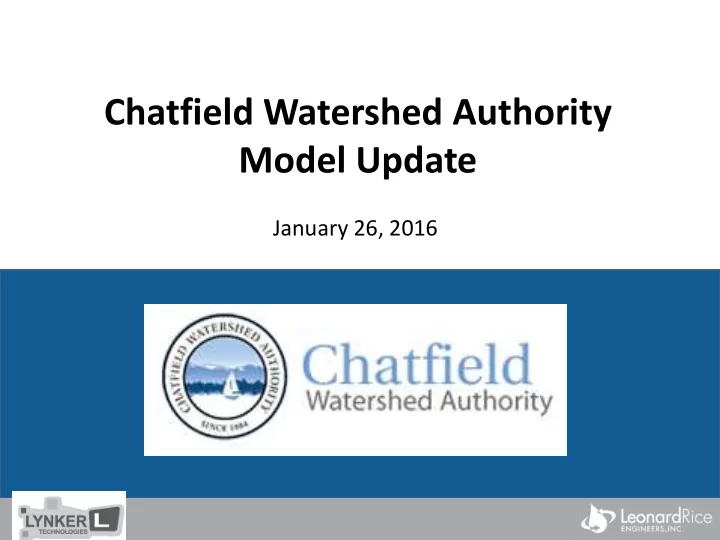

Chatfield Watershed Authority Model Update January 26, 2016
Introduction Project Overview Phase 1 • Data compilation -> Memo, database Phase 2 • Model selection -> HSPF • Build model inputs • Delineate watershed • Initial model build • Model calibration and validation – Hydrology, sediment, water quality • Model results -> Memo Phase 3 • Model training
Watershed Delineation and DEM • Watershed delineated according to best practices for the HSPF model – 160 subbasins, 160 reaches • Additional considerations: – USGS flow monitoring locations – Land use – Topography – Water quality sampling – Point sources – Diversions
Model Segmentation Overview • Model segments are the way HSPF incorporates spatial data into an otherwise “lumped” parameter model • Capture the variability of the watershed in a simplified manner Example A: 1 segment * 3 land uses = 3 parameter sets • Example A: If there were 1 model segment, the model would be parameterized according to the different land uses. Assuming 3 land use categories, there would be 1 * 3 = 3 different pieces to parameterize B: If there were 2 model segments and 3 land use types, there would be 2 * 3 = 6 Example B: different parameter sets 2 segments * 3 land uses = 6 parameter sets
Model Segmentation – Precipitation Precipitation Analysis • Daily observed precipitation (NOAA) was compared to daily gridded PRISM precipitation (Oregon State University) – Highly correlated • PRISM grid cells were used to determine spatial correlation • PRSIM grid cells were grouped based on average annual precipitation and spatial correlation • Weighted average daily precipitation used for each climate group (1-4)
Model Segmentation – Temperature Temperature Analysis • 5 long-term temperature stations near the watershed – Kassler, Roxborough, Castle Rock, Strontia Springs, and Monument • Final Temperature Groups – Group 1: Roxborough (elevation adjusted in HSPF) – Group 2: Monument (elevation adjusted in HSPF) – Group 3: Average of Roxborough and Castle Rock matched seasonality of Larkspur and correlated well – Group 4: Average of Kassler and Castle Rock
Model Segmentation – Final
Land Use Total Watershed Area = 419.15 mi 2 • Open water = 2.64 mi 2 (0.63%) • Urban, low density = 34.8 mi 2 (8.3%) – 20% imperviousness • Urban, high density = 7.45 mi 2 (1.8%) – 65% imperviousness • Forest = 155.2 mi 2 (37.0%) • Grassland-Shrub = 205.7 mi 2 (49.1%) • Pasture/Hay = 0.38 mi 2 (0.09%) • Cultivation = 3.20 mi 2 (0.76%) – Updated with CDSS irrigated lands • Wetlands = 9.73 mi 2 (2.32%)
Flow and Water Quality
Initial Hydrologic Calibration South Platte River • Outflow from Strontia SP @ Strontia Springs (Model Inflow) [Rch 41] 500000 Springs Reservoir has 400000 Flow (AF) 300000 been added as model 200000 inflow 100000 0 • South Platte River at Waterton Canyon PLASTRCO Simulated RCH41 matches the shape of South Platte @ Waterton [Rch 29] historical flow, but is 500000 400000 biased high Flow (AF) 300000 200000 – Diversions still need to 100000 be removed from the 0 South Platte River PLATWATCO Simulated RCH29
Initial Hydrologic Calibration Plum Creek Tributaries • East Plum Creek at East Plum Creek @ Castle Rock [Rch 56] 40000 Castle Rock matches 30000 Flow (AF) 20000 well with historical 10000 USGS record 0 • West Plum Creek at USGS 06708800 Simulated RCH 56 Perry Park matches fairly well with West Plum Creek @ Perry Park [RCH 118] 7000 (limited) historical 6000 5000 Flow (AF) USGS record 4000 3000 2000 – This gage is operated 1000 0 April - September beginning in 2009 USGS 06708600 Simulated RCH 118
Initial Hydrologic Calibration Plum Creek Plum Creek @ Sedalia (Confluence) [Rch 45] • Plum Creek at Sedalia 120000 100000 and Plum Creek at Titan 80000 Flow (AF) 60000 Road are similar due to 40000 drainage areas and 20000 0 geographic proximity • Initial results are biased USGS 06709000 Simulated RCH45 high for both calibration sites Plum Creek @ Titan Rd [Rch 28] 120000 – We know there is strong 100000 Flow (AF) 80000 interaction with the 60000 40000 groundwater, which 20000 causes river to go dry 0 – Model spin up period is 1995-1998 USGS 06709530 Simulated RCH28
Looking Ahead Model Calibration and Validation • Finalize hydrologic calibration • Calibrate sediment in model • Calibrate water quality in model • Deliver calibrated model and model report
Extras Online Watershed Map http://arcg.is/1PxQQkH
Recommend
More recommend